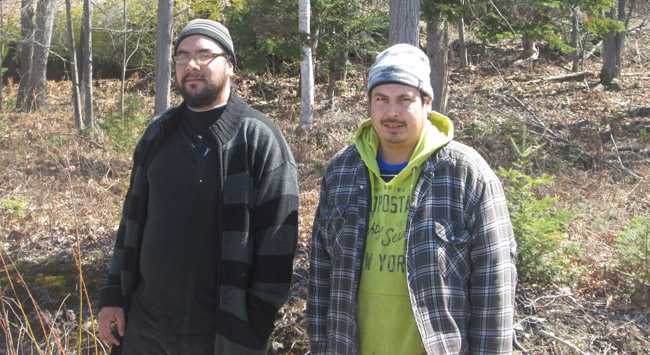Demonstrations to happen against ‘Round Up’

By Leslie Knibbs
MISSISSAUGA #8 FIRST NATION – The Traditional Ecological Knowledge Elders Group (TEK) met on April 14 at Mississaugi First Nation to discuss the next move in their ongoing battle to stop chemical spraying of forests and consequently end the resulting negative effects on health and the environment. The chemical spray suspected of casting this dark shadow of harm, and, causing the most serious problem is Glyphosate, commonly known as “Round-up”.
According to Physicians for the Environment, a proactive group of medical doctors advocating for a safe environment, the sole purpose of this chemical is, “it is designed to kill.” In a CBC interview last year on August 20, a day after the first TEK meeting, and, in response to the elders’ concerns, Gideon Foreman, Director of Physicians for the Environment aligned his group with the elders stating his group also has serious concerns about aerial spraying because of its negative effect on beneficial insects, frogs and other amphibians. Foreman went on to say however, regulations regarding the use of chemicals is regulated by the Federal Government and any research done to determine whether or not a chemical agent is used is provided to Health Canada by the users of the product or products. Clearly, Foreman and his group are part of an informal, yet, growing coalition initiated by TEK group to put a stop to aerial spraying
Seemingly, much progress has been made since their initial meeting on August 19, 2014, TEK group has established a plan of action to target the problem. Since first meeting, TEK group has quickly become the vanguard in the fight to stop spraying, a wise and learned voice for a growing ground force of many fighting to end the use of harmful chemicals in in North Ontario forests. Allies include most municipalities from Sudbury to Sault Ste. Marie, all First Nation territories throughout the northeast region as well as farmers, hunters and fishermen. One example is farmer, town councillor, fisherman and hunter Charlie Smith from Sables Spanish River Township. Smith has attended TEK meetings making it clear the Elders have full support of his township as have others.
Anishinabek Nation Deputy Grand Council Chief Glen Hare attended the April 14 meeting saying any demonstrations against spraying would undoubtedly have full public support. Hare made it clear in his mind when the cause is a just cause, as the Elders campaign is, and, for the public good such as putting a stop to the spraying, all the public would support it.
At the present time, the branch of Health Canada responsible for registration and regulation of pesticides, the Pest Management Regulatory Agency (PMRA) is re-evaluating the use of any chemicals registered before January 1, 1995 to determine if their use continues to be acceptable under today’s standards for health and protection of the environment. Glyphosate was registered just over 30 years ago and now requires a re-evaluation, a much needed one as far as the Elders and many others are concerned.
In an email response to TEK concerns represented by MPP Michael Mantha’s office, Robert Martin, a representative with PMRA responded to the elders’ concerns, stating, indeed his department of Health Canada is looking into the safety of using Glyphosate. He said the PMRA “will be working closely with the US Environmental Protection Agency (EPA) in the re-evaluation of glyphosate to determine if it safe to use in aerial spraying. Once completed, a consultation document will be published on Health Canada’s website.
It’s interesting to note, the chemical glyphosate is banned by Health Canada from use in gardens and lawns because it is considered unsafe for use yet continues to be used in the forestry industry as well as along hydro lines in the bush.
Plans of action by the TEK group include a petition circulated throughout Northern Ontario and an online petition to phase out the spraying by the forestry industry and all partners as well as the Minister of Natural Resources in forests and near watersheds. Other plans include highway demonstrations at key points along the main corridors throughout Northern Ontario, and on site demonstrations along hydro lines when and where spraying is done. Demonstrations are planned to begin during the first month of summer. Elders at the April meeting stressed all demonstrations must be done peacefully with the safety of all a main priority.
Plans are being set in motion by Kyle Chiblow and trapper Geoffery Daybutch, two young men from Mississaugi First Nation to demonstrate at the site of spraying. Chiblow and Daybutch assured the Elders many of the young people including those in the “Idle No More” movement were prepared to show their solidarity with the elders by demonstrating and protesting in the bush at the sites of spraying.
Ontario Provincial Police Constable Kim Wright attended the April meeting outlining the do’s and don’ts as to legal ramifications when demonstrating. As part of the provincial liaison team, Wright made it clear her team is not in the business of stopping demonstrators, but rather to ensure the demonstrations are carried on in a peaceful and safe manner for all concerned. Elders Willie Pine and Raymond Owl, assured Wright and others attending the meeting they too have the same purpose in mind.


